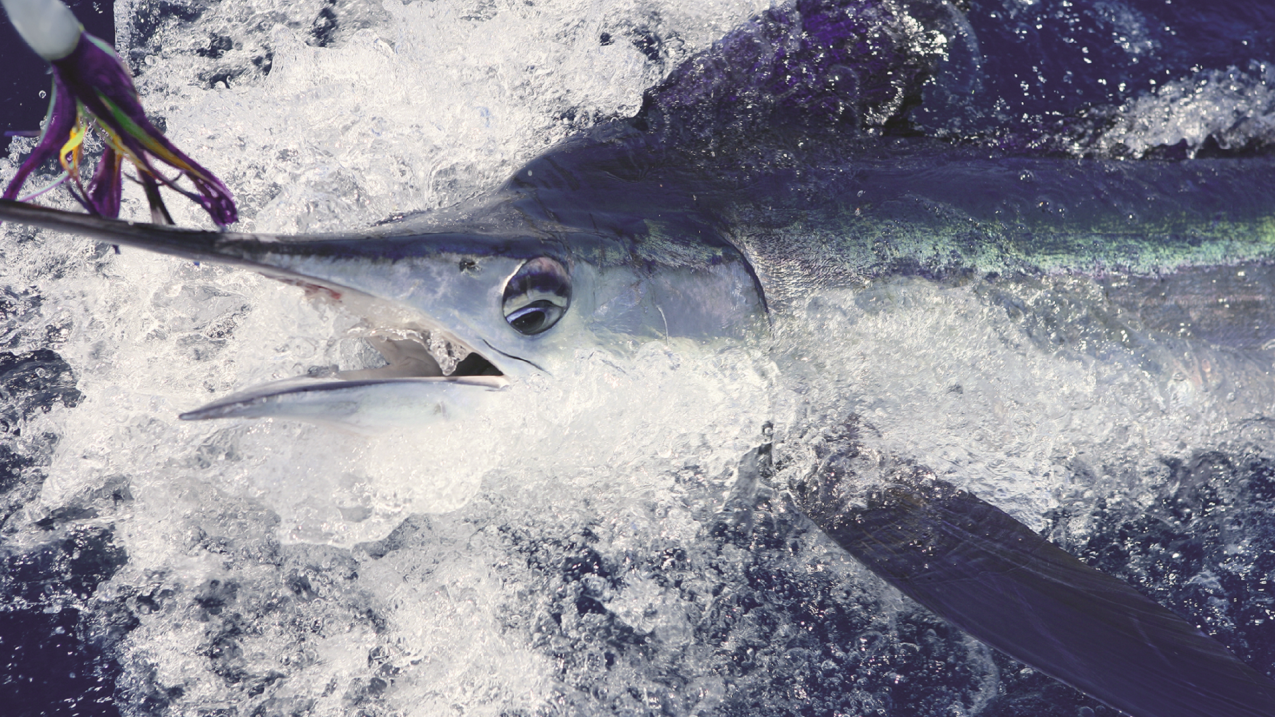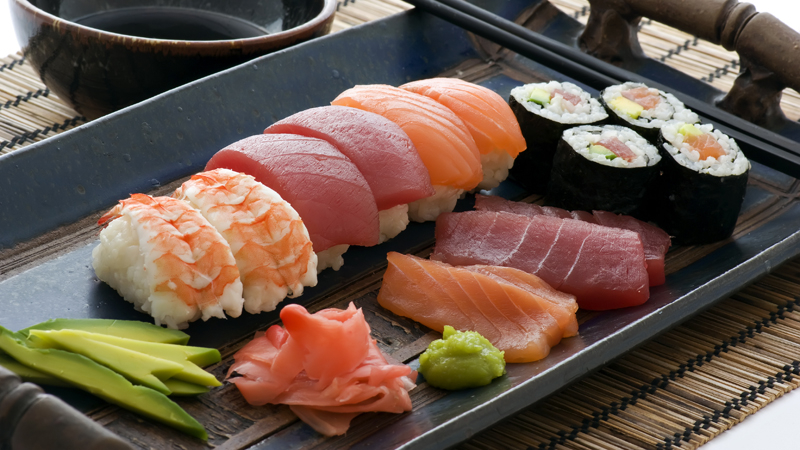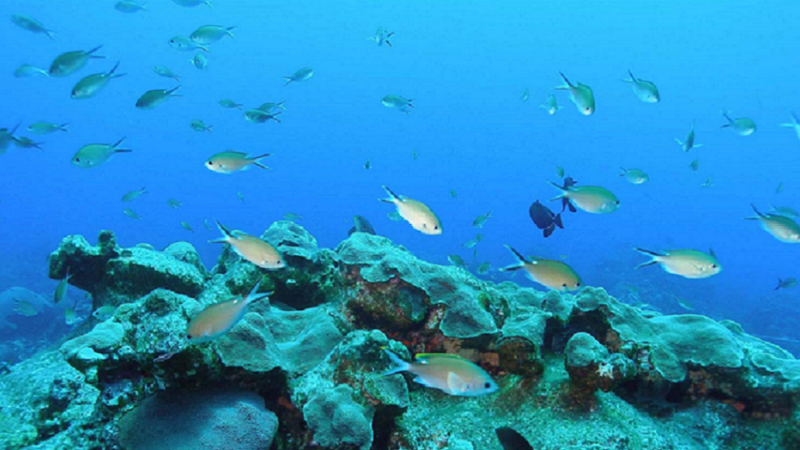
Recreational fishing for species such as swordfish is a major industry in the U.S. (Image credit: Shutterstock)
Sustaining our nation’s fisheries
Why fish matter
Seafood benefits
Success by the numbers
NOAA’s role
The word fish can bring any number of thoughts to mind. A colorful creature of beauty swimming in bright blue water. A family dinner of cedar grilled salmon with a little oil and salt. Or people – beachgoers with a rod and reel, commercial fishermen spending days at sea, or fish farmers measuring conditions to grow a harvest.
Then there are the restaurants, grocery stores, and markets buying and selling seafood to customers in an exchange that’s been a part of our nation’s history since long before the penning of our Declaration of Independence. NOAA recognizes fish are all these things — tourism, food and an important component of our economy.
474
—Number of fish stocks or stock complexes NOAA tracks
As the agency responsible for sustaining our nation’s fisheries, NOAA plays a vital role in working for both the fish and the fishermen. Amid a dynamic climate, NOAA continually takes the pulse of our ecosystems and the fish stocks that rely on them — using cutting-edge science to understand what is happening species by species.
Scientists use that data to make informed decisions to effectively manage commercial, recreational and subsistence fisheries. The goal is to keep fish stocks healthy, sustainable and resilient.
If you’re like the average American, you probably aren’t eating enough seafood. Whether you catch it yourself or buy it at the market, replacing some of your typical proteins with seafood is a gift you can give to both your body and the planet.
Nutritional guidelines say Americans need to eat more seafood — two servings per week as part of a healthy diet. It’s a lower-calorie protein than meat and poultry and full of heart-healthy omega-3 fatty acids. Seafood is also a great source of vitamins D, A, C and E — meaning it’s a boost for your bones, eyes, skin and immune system all at the same time. Seafood is even rich in iodine, calcium, phosphorus, selenium and other important minerals.

Then there is the health of the Earth and future generations to think about. With a fast-growing world population, the demand for food is growing too. Fish leave behind a smaller carbon footprint than other popular protein sources. And expansion of farmed fisheries, as a complement to wild harvest, is one way to reduce the need for imports — answering a consumer movement towards the “locally grown.” NOAA Fisheries hopes to grow our nation’s number of farmed fisheries to increase supply and help keep fisheries sustainable.
The United States turned the corner on ending chronic overfishing — rebuilding 39 fish stocks since the year 2000. Our successes include rebuilt stocks in every region of the country — such as golden tilefish in the Mid-Atlantic, canary rockfish along the West Coast and gag grouper in the Gulf of Mexico.
But the ocean is a dynamic place, and fish management is always evolving. Sustainable fisheries are a continuous journey, not a destination. NOAA and our partners continually monitor our dynamic ocean resource to figure out if overfishing is happening. When we find it, we respond quickly and then enforce sustainable measures and practices. And the proof — overfishing and overfished numbers are at near-record lows.

43
—The number of once-overfished stocks considered rebuilt since the year 2000
Our Status of the Stocks Report shows 91 percent of stocks are not subject to overfishing — that’s what happens when the harvest rate is too high. And 84 percent of fish stocks are not overfished — where the population size is too low. But the total number of stocks subject to either category is always changing. Typically, some are removed from a list each year.
Even when a stock is overfished, the U.S. fisheries management system allows a limited harvest to keep fishermen working while the fishery rebuilds. This rewards fishermen for compliance and stewardship and keeps our economy going while the species grows in number. U.S. federal fisheries are all under the same robust fishery management plans and held accountable to sustainability standards. NOAA Fisheries works to support the fishermen who play by the rules to help keep the U.S. a global leader in sustainable fisheries management.
The Magnuson-Stevens Act — which celebrated its 40th birthday in April 2016 — is the primary law governing fishing in the U.S. Enacted in 1976, this visionary legislation set up a system that partners NOAA with states and stakeholders to work on fishery management.
Over time, we’ve built a robust science-based management process to assess and predict fish stocks, establish catch limits and reduce bycatch. The goal is to keep fish and marine mammal stocks healthy, sustainable and resilient to support a vibrant economy and ecosystem for future generations.

From Arctic to Caribbean climates and from small subsistence fisheries to large industrial fleets, U.S. fisheries are quite diverse. Through our regional fishery management councils, every state has key stakeholders at the table, including the fishers, conservationists, and scientists. The U.S. also has three state fishery management commissions.
States generally manage fisheries within three miles of the coastline, while NOAA regulates from there out to about 200 miles from shore. NOAA is responsible for managing 11.4 million square miles of ocean — the largest fisheries jurisdiction in the world. Beyond 200 miles, you enter international waters. NOAA does manage U.S. fleets in international waters and we work, negotiate and build capacity in the international arena to keep global fisheries covered too. Enforcing compliance is key to creating a level playing field for American fishermen.
In June 2014, President Obama launched a multi-agency task force to combat illegal, unregulated, and unreported (IUU) fishing and seafood fraud. In March 2015, the task force published a final action plan with a list of recommendations. NOAA is taking a lead role in implementing these recommendations. For more details and to give your input, visit the IUU web portal.
The word fish can bring any number of thoughts to mind. A colorful creature of beauty swimming in bright blue water. A family dinner of cedar grilled salmon with a little oil and salt. Or people – beachgoers with a rod and reel, commercial fishermen spending days at sea, or fish farmers measuring conditions to grow a harvest.
Then there are the restaurants, grocery stores, and markets buying and selling seafood to customers in an exchange that’s been a part of our nation’s history since long before the penning of our Declaration of Independence. NOAA recognizes fish are all these things — tourism, food and an important component of our economy.
474
—Number of fish stocks or stock complexes NOAA tracks
As the agency responsible for sustaining our nation’s fisheries, NOAA plays a vital role in working for both the fish and the fishermen. Amid a dynamic climate, NOAA continually takes the pulse of our ecosystems and the fish stocks that rely on them — using cutting-edge science to understand what is happening species by species.
Scientists use that data to make informed decisions to effectively manage commercial, recreational and subsistence fisheries. The goal is to keep fish stocks healthy, sustainable and resilient.
If you’re like the average American, you probably aren’t eating enough seafood. Whether you catch it yourself or buy it at the market, replacing some of your typical proteins with seafood is a gift you can give to both your body and the planet.
Nutritional guidelines say Americans need to eat more seafood — two servings per week as part of a healthy diet. It’s a lower-calorie protein than meat and poultry and full of heart-healthy omega-3 fatty acids. Seafood is also a great source of vitamins D, A, C and E — meaning it’s a boost for your bones, eyes, skin and immune system all at the same time. Seafood is even rich in iodine, calcium, phosphorus, selenium and other important minerals.

Then there is the health of the Earth and future generations to think about. With a fast-growing world population, the demand for food is growing too. Fish leave behind a smaller carbon footprint than other popular protein sources. And expansion of farmed fisheries, as a complement to wild harvest, is one way to reduce the need for imports — answering a consumer movement towards the “locally grown.” NOAA Fisheries hopes to grow our nation’s number of farmed fisheries to increase supply and help keep fisheries sustainable.
The United States turned the corner on ending chronic overfishing — rebuilding 39 fish stocks since the year 2000. Our successes include rebuilt stocks in every region of the country — such as golden tilefish in the Mid-Atlantic, canary rockfish along the West Coast and gag grouper in the Gulf of Mexico.
But the ocean is a dynamic place, and fish management is always evolving. Sustainable fisheries are a continuous journey, not a destination. NOAA and our partners continually monitor our dynamic ocean resource to figure out if overfishing is happening. When we find it, we respond quickly and then enforce sustainable measures and practices. And the proof — overfishing and overfished numbers are at near-record lows.

43
—The number of once-overfished stocks considered rebuilt since the year 2000
Our Status of the Stocks Report shows 91 percent of stocks are not subject to overfishing — that’s what happens when the harvest rate is too high. And 84 percent of fish stocks are not overfished — where the population size is too low. But the total number of stocks subject to either category is always changing. Typically, some are removed from a list each year.
Even when a stock is overfished, the U.S. fisheries management system allows a limited harvest to keep fishermen working while the fishery rebuilds. This rewards fishermen for compliance and stewardship and keeps our economy going while the species grows in number. U.S. federal fisheries are all under the same robust fishery management plans and held accountable to sustainability standards. NOAA Fisheries works to support the fishermen who play by the rules to help keep the U.S. a global leader in sustainable fisheries management.
The Magnuson-Stevens Act — which celebrated its 40th birthday in April 2016 — is the primary law governing fishing in the U.S. Enacted in 1976, this visionary legislation set up a system that partners NOAA with states and stakeholders to work on fishery management.
Over time, we’ve built a robust science-based management process to assess and predict fish stocks, establish catch limits and reduce bycatch. The goal is to keep fish and marine mammal stocks healthy, sustainable and resilient to support a vibrant economy and ecosystem for future generations.

From Arctic to Caribbean climates and from small subsistence fisheries to large industrial fleets, U.S. fisheries are quite diverse. Through our regional fishery management councils, every state has key stakeholders at the table, including the fishers, conservationists, and scientists. The U.S. also has three state fishery management commissions.
States generally manage fisheries within three miles of the coastline, while NOAA regulates from there out to about 200 miles from shore. NOAA is responsible for managing 11.4 million square miles of ocean — the largest fisheries jurisdiction in the world. Beyond 200 miles, you enter international waters. NOAA does manage U.S. fleets in international waters and we work, negotiate and build capacity in the international arena to keep global fisheries covered too. Enforcing compliance is key to creating a level playing field for American fishermen.
In June 2014, President Obama launched a multi-agency task force to combat illegal, unregulated, and unreported (IUU) fishing and seafood fraud. In March 2015, the task force published a final action plan with a list of recommendations. NOAA is taking a lead role in implementing these recommendations. For more details and to give your input, visit the IUU web portal.

